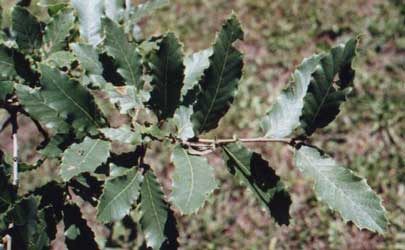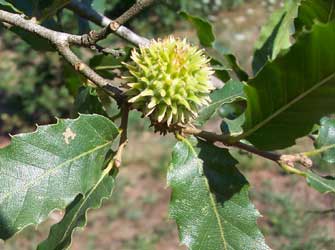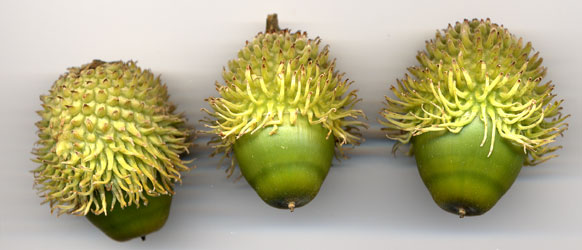| Quercus trojana | |
| Author | Webb 1839 Gard. Mag. & Reg. Rural Domest. Improv. 15: 590 |
| Synonyms | aegilops
Griseb. 1844, not L aegilops var. macedonica (A.DC) Fiori & Paol. 1898. grisebachii Kotschy 1891 macedonica A.DC 1864 trojana Jaubert & Spach 1842 trojana f. macrobalana Gavioli 1935 |
| Local names | Trojan
oak; Macedonia's oak; |
| Range | SE Italy; the Balkans; Asia Minor; 300-1800 m; introduced in Europe in 1890; |
| Growth habit | not exceeding 15-18 m, with trunk to 0.6 m in diameter; crown at first conical, then domed; |
| Leaves | 3-9 x 1.5-2.3 cm; semi-evergreen; leathery; oblong or oblong-lanceolate ; apex pointed acuminate; base rounded or subcordate; margin toothed, with 6-12 pairs of mucronate teeth; both sides glabrous and slightly glaucous, but somtimes with short, stellate hairs beneath; 8-14 veins pairs raised under, at an angle of 45° with midrib; tertiary veins prominent beneath; petiole 0.2-0.6 cm, sparsely hairy; |
| Flowers | male flowers with perianth hairy, but with glabrous anthers; female flowers subsessile, with 4-5 elongated styles; |
| Fruits | acorn 2.7-4.5 cm long, 1.8-2 cm in diameter; 1 to 3 on a 2-5 mm long, pubescent, thick rachis; apex truncate; cup sessile or nearly so, 2.5 cm in diameter, very variable, with long, spreading or recurved, or appressed scales, enclosing 2/3 of nut or more; maturing in 2 years; |
|
Bark, twigs and |
bark grey brown, furrowed; twigs brown green, sometimes with a few stellate hairs, turning grey brown; bud small, 2 mm long, with persistent stipules around terminal one; |
| Hardiness zone, habitat | hardy; all types of soils; fast-growing; |
| Miscellaneous | -- A. Camus : tome 1, p. 563,
n° 119; -- Sub-genus Cerris, Section Cerris, sub-section Libani (with afares, and libani); -- Resembles Q.cerris, but cup scales are not so long, leaves are less lobed, buds lack the long setose stipules; resembles also Q.libani, but smaller leaves with short and pointed teeth, and shorter petioles; |
| Subspecies and varieties |
-- subsp yaltirikii Zielinski,
Petrova & Tomaszewski 2006 -- Q. euboica (Papioann.) K.I.Chr. 1997
Fl. Hellenica 1: 45 |
| Pictures |
|




